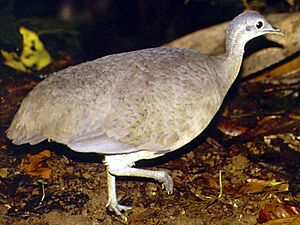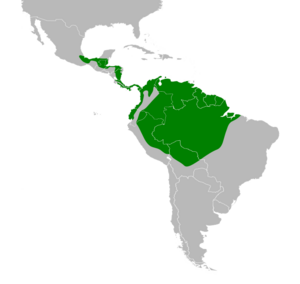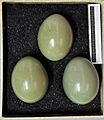Great tinamou facts for kids
Quick facts for kids Great tinamou |
|
|---|---|
 |
|
| Conservation status | |
| Scientific classification | |
| Genus: |
Tinamus
|
| Species: |
major
|
| Subspecies | |
|
See text |
|
 |
|
| Synonyms | |
|
|
The great tinamou (Tinamus major) is a special ground bird that lives in the forests of Central and South America. It's a type of tinamou, and there are many different kinds, mostly known by their unique colors.
Contents
About the Great Tinamou
The great tinamou is a large bird, usually about 38 to 46 centimeters (15 to 18 inches) long. It can weigh between 700 to 1249 grams (1.5 to 2.7 pounds). Even though it's called "great" and looks a bit like a big pheasant or a small turkey, it's not always the biggest tinamou species.
This bird is usually olive-green, which helps it blend in with the forest. It has a white throat and belly, black stripes on its sides, and a cinnamon-colored area under its tail. Its head and neck are reddish-brown, and it has blackish feathers on the back of its head and above its eyes. Its legs are blue-grey. All these colors help the great tinamou hide well in the thick rainforest.
The great tinamou has a special call. It makes three short, shaky, but loud piping sounds. You can often hear these calls in the rainforest during the early evenings.
Where They Live
Great tinamous live in warm, wet forests. These include rainforests, lowland evergreen forests (where trees stay green all year), river-edge forests, swamp forests, and cloud forests. They can be found at heights from about 300 to 1500 meters (1,000 to 5,000 feet) above sea level.
Unlike some other tinamous, the great tinamou is quite good at living even when parts of its forest home are cut down. They often build their nests at the bottom of a tree.
Reproduction and Life Cycle
The great tinamou has a very interesting way of raising its young! It's a polygynandrous species, which means both males and females have multiple partners during the breeding season. But here's the cool part: only the male tinamou takes care of the eggs and chicks.
A female tinamou will mate with a male and lay about four eggs. The male then sits on these eggs to keep them warm until they hatch. He takes care of the baby chicks for about three weeks. After that, he leaves to find another female. Meanwhile, the female has been busy laying eggs with other males. She might start nests with five or six different males during one breeding season, leaving all the parenting duties to them! The breeding season is quite long, lasting from mid-winter to late summer.
The eggs of the great tinamou are large, super shiny, and can be bright blue or violet. Their nests are usually simple scrapes on the ground, often near the big, wide roots of trees.
Except when they are mating, great tinamous usually live alone. They wander through the dark forest floor, looking for food. They eat seeds, fruits, and small animals like insects, spiders, frogs, and small lizards that they find in the fallen leaves. They especially love fruits from trees like Lauraceae, annonaceae, myrtaceae, and sapotaceae.
Conservation Status
The great tinamou lives across a very large area, about 6.6 million square kilometers (2.5 million square miles). Because of this, it is listed as "Least Concern" on the IUCN Red List of Threatened Species. This means that experts don't think it's in danger of disappearing anytime soon. Even though people sometimes hunt them, it doesn't seem to have a big effect on their overall numbers.
Images for kids



